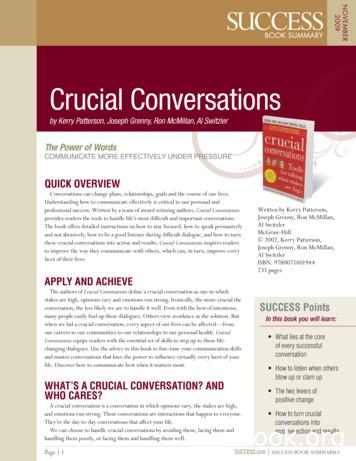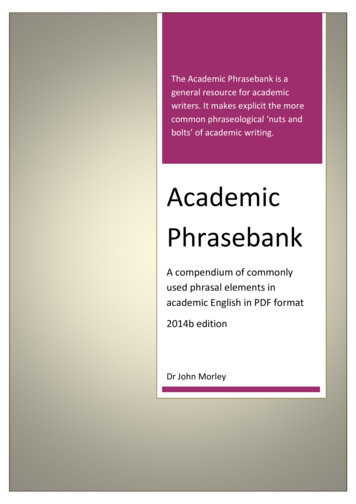CRUCIAL CONVERSATIONS AND CRUCIAL CONFRONTATIONS
CRUCIAL CONVERSATIONS ANDCRUCIAL CONFRONTATIONSBOOKS BY: PATTERSON, GRENNYMcMILLIAN, and SWITZLERPUBLISHER: McGRAW HILLBIBLICAL BASIS FOR USING SUCH BOOKS AND THIS PRESENTATIONJames 3:9-12: Our tongues are not to produce inconsistency when we use them.Ephesians 4: 25, 29-32: The Holy Spirit is grieved when we use our tongues improperly,including the failure to rebuke in love.Colossians 3:8-17: All we are to do in word and deed is to honor the Lord Jesus Christ.I Peter 4:11: All gifts, whether speaking or serving ones, are to be used for building eachother up and so that our God may be praised.Matthew 5:37: Our yes is to mean yes and our no is to mean no, anything else representsthe work of the Evil One.THE NEED TO COME BACK TO BIBLICAL CONVERSATIONS ANDCONFRONTATIONS1. Many congregations are filled with gossip, rumor, and slander that is never confrontedor dealt with by the leaders.2. Most resistance to an outward focused ministry comes through passive aggressivebehaviors that hinder the congregation’s mission rather than enhancing it.3. Many pastors and lay leaders do not and will not confront issues hoping often that byremaining silent the problems will disappear.4. Most people today do not know how to deal with problems constructively. Yet welive in an angry culture. When key confrontations and conversations do occur they moreoften divide rather than providing healing and restoration.1
DESCRBING CRUCIAL CONVERSATIONS AND CONFRONTATIONS1. A crucial conversation is a discussion between two or more people where:Stakes are highOpinions varyEmotions run strong2. Crucial conversations are about disagreements. (Disagreements not handled welllead to:Strained relationshipsPoor decisionsDisastrous results3. All of us face three choices when it comes to crucial conversations. Those choicesare:We can avoid themWe can face them and handle them poorlyWe can face them and handle them well4. A crucial confrontation is holding someone accountable face to face.5. Crucial confrontations are about disappointments. They consist of:Failed promisesMissed expectationsAll other bad behavior2
CRUCIAL CONVERSATIONS1. The following are samples of crucial conversations:Ending a relationshipAsking a friend to repay a loanGiving the pastor feedback about behavior and/or speaking issuesCritiquing another staff member’s ministryResolving issues related to children between former spousesTalking with a key board member who is not keeping commitmentsConfronting a congregational member about abuse issuesProviding an unfavorable staff evaluation2. The key thing for having any crucial conversation that is effective is to get all relevantinformation out on the table. In crucial conversations all parties to the conversationhonestly and openly share their feelings, express their opinions, and articulate theirtheories. Such an experience is called dialogue.3. Crucial conversations occur when there is a shared pool of meaning. This pool ofmeaning becomes filled when everyone in the conversation feels safe to share theirunderstandings and meanings about that which is being discussed. As this pool ofmeaning grows two things happen:Better decisions are made since everyone has more informationPeople will act on the decisions that have been made4. Any crucial conversation that I want to have must start with what happens in mybeing. (IN ANY CONVERSATION THE ONLY ONE I CAN CONTROL IS ME)!I must ask my self three questions:What do I really want for myself in this conversation?What do I really want for others in this conversation?What do I want the relationship(s) to be when the conversation is over?3
I must also refuse the “sucker’s choice”:The sucker’s choice is to assume that any conversation can only have a win/loseoption if I initiate it with whomever. This means I am always looking for the elusive andbefore I begin the conversation. This and starts to emerge when I begin clarifying what Ido and do not want to happen as the result of any conversation.5. If I want the best from any conversation I must always think about how to make theconversation safe before I begin. Safety relates to two issues: content and conditions.The content is a given (Is the subject of this conversation something that the person(s) Iam talking with dread talking about)? The conditions relate to either silence or anger.This is how fear gets into any RControllingLabelingAttacking6. In crucial conversations we think about the safety issue and how to make theconversation safe.1. You step out of the issue and build safety before continuing conversation.2. You establish mutual purpose.3. You establish mutual respect.(I have known a thousand scamps; but I never met one who considered himself so. Selfknowledge isn’t so common. – Ouida)7. I must also take charge of my emotions before beginning any crucial conversation.That is easier said than done. However, the way it is done is by examining the stories inour head about the situation before talking. Stories are our interpretation of the facts.They explain to us what is happening, why it is happening, and how it is happening. Theresult of creating such stories is to make judgments about the situation and the personsinvolved and once those judgments are made our emotions take over.8. There are specific steps to take in creating an effective crucial conversation. Thosesteps are as follows:1. Share facts not opinions, emotions, and judgments.2. Tell your story so people know your interpretation.3. Ask the other person(s) to share their facts and interpretation.4. Maintain tentativeness throughout the conversation.5. Invite solutions to deal with the issues.(Always work at maintaining safety throughout the entire conversation).4
9. In crucial conversations related to making important decisions that involve a numberof people, four key questions must be asked:1. Who really cares about the decision?2. Who has the best expertise to help make the decision?3. Whose cooperation is required to implement the decision?4. How many people need to be involved in the decision?Once these questions are answered all these people need to be involved in the crucialconversation.10. In crucial conversations two key levers always come into play and they are:1. Do we want true dialogue or is there another agenda?2. How do we make the conversation safe?CRUCIAL CONFRONTATIONSOne of my problems is that I internalize everything. I can’t express anger; I grow atumor instead. – Woody Allen1. The benefits of living and working in a healthy confronting environment are:Increased accountabilityHigh moraleEffectiveness2. As in crucial conversations I must start with me before I worry about dealing with theperson I feel needs confronting.1. I learn to determine that which is or is not crucial and needs confronting.CPR helps me get at the right issue.Content: This relates to the facts of what did or did not happen.Pattern: The same issue constantly re-occurs.Relationship: The issue is impacting your mutual relationship.5
2. I must master my story, which is my interpretation (with emotion) of the facts.Am I assuming that others know my perspective and values?Am I assuming the best or the worst in the actions of others?3. Confrontations are always about a gap. There is a gap between what we expected andwhat occurred. Our job in a confrontation is to describe the gap.1. I must always start with safety.State facts and describe the gap (often means stepping outside emotions)Reflect mutual purposeReflect mutual respect2. Share my path, which means:State the facts again.Tell my story.Share my feelingsTentatively state your conclusion3. End with a question which means:Ask for their honest response.Hear their story.Attempt to understand their motivations.4. It is at this point I must begin to deal with proper motivation to help the person towant to bridge the gap between their performance and my expectations.1. The use of power usually means I have lost.2. Perks are often a temporary stop gap.3. Personal charisma is usually also a temporary stop gap.4. Instead explore natural consequences.6
5. Focus on long-term benefits.6. Reveal hidden victims.5. Once the confrontation has been stated and there is mutual agreement that the gapmust be closed then develop a mutually agreed upon plan that includes follow-up. Theplan should include WWWF.1. WHO: Be sure and put a name to each task that is to be accomplished.2. WHAT: It is stated what will be done and how well it will be done.3. WHEN: A specific deadline is delineated for evaluation.4. FOLLOW UP: Who, when, and how it will be done and by what date.6. PRAISE is a crucial solution to problem solving and should always be used betweenconfrontations.1. Praise more than you think you should and then double it.2. Praise individuals in private and groups in public.3. Praise both process and results.4. Praise in spontaneous ways.7
DESCRBING CRUCIAL CONVERSATIONS AND CONFRONTATIONS 1. A crucial conversation is a discussion between two or more people where: Stakes are high Opinions vary Emotions run strong 2. Crucial conversations are about disagreements. (Disagreements not handled well lead to: Strained relationships Poor decisions Disastrous results 3.
When I chose the book, Crucial Confrontations, I was expecting to read a human resource book about dealing with difficult co-workers. I was pleasantly surprised that the authors of Crucial Confrontations not only described ways to have difficult conversations at work, but
Difficult Conversations: How to Discuss What Matters Most by Douglas Stone The SPEED of Trust: The One Thing That Changes Everything by Stephen M.R. Covey About the Author This award-winning team of authors has produced three New York Times Best-Sellers: Crucial Conversations, Crucial Confrontations and Infl uencer. They are also sought-after
Conversations and review Kerry Patterson’s excellent book on Crucial Confrontations. Bill Cropper, Director – The Change Forum What’s in this Issue page Dealing with Defensiveness 1 Performance Conversations 2 Book Review: Crucial Confrontations 2 Difficult Discussions – ‘drops on you’ 3 Helping Leaders Tackle Hard Talks 4
SOCIAL STYLE and Crucial Conversations 2 Overview The book "Crucial Conversations"1 provides advice for having conversations when failure is a strong possibility. The authors (Patterson, Grenny, McMillan & Switzler) provide a model for working through potentially disastrous conversations in a way that increases the chances
other performance gaps. The authors explore how to step up to and master crucial confrontations. A crucial confrontation consists of a face-to-face accountability discussion – someone has disappointed you and you talk to him or her directly. When handled well, the File Size: 770KB
and Crucial Confrontations: Tools for Resolving Broken Promises, Violated Expectations, and Bad Behavior. “[Crucial Conversations] is a breakthrough book. I found myself being deeply influenced, motivated, and inspired.” Stephen R. Covey, author of The 7 Habits of Highly Effective People “Crucial Conversations is one of the most powerful
Crucial Conversations - Holding a discussion between two or more people where (1) stakes are high, (2) opinions vary, and (3) emotions run strong, seeking successful resolution and action through respectful dialogue. Crucial Confrontations - Holding someone accountable for broken promises, violated expectations, or bad behavior
The Academic Phrasebank is a general resource for academic writers. It aims to provide the phraseological ‘nuts and bolts’ of academic writing organised according to the main sections of a research paper or dissertation. Other phrases are listed under the more general communicative functions of academic writing.























